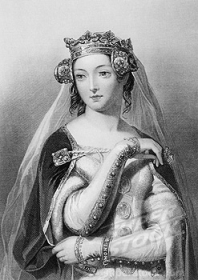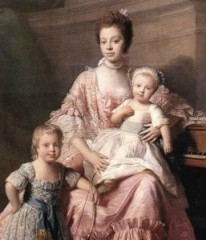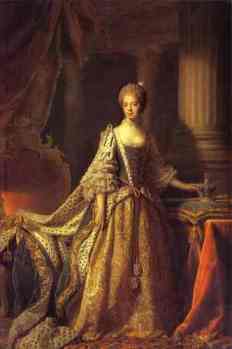2019 Note: Comments are turned off site-wide due to the frankly disgusting onslaught of racist (both leanings) messages I receive on this post almost on a daily basis. I am happy to leave the post up as when I wrote it I believed (and still do) that’s it’s an interesting little topic. Take it, or leave it, but – please – there’s no need to spend time crafting a ranting comment, as none will be approved. Thanks! Love to all (but not the racists), Erin x
When you consider historical Queens of England, you probably picture sumptuous dresses, ropes of jewels, tumbling fair or chestnut curls and peaches-and-cream complexions. Would it surprise you to know that two queens of England are now considered by some historians and genealogists to have had “black” or Moorish ancestry? Interestingly, the two ladies – whilst separated by centuries – had much in common; both were especially beloved in their lifetimes and are still remembered particularly fondly today.
Philippa of Hainault (24 June 1314 – 15 August 1369) was the Queen-Consort of Edward III. She was the daughter of the Count of Hainault in the Low Countries (now in Belgium), an area that had once been ruled by Moorish tribes. It would appear that perhaps, in Philippa, there was a genetic throwback to the darker colouring of the erstwhile rulers. Edward II sent a man to Hainault to report back on his son and heir’s mooted bride. The man gave the following feedback:
“The lady whom we saw has not uncomely hair, betwixt blue-black and brown. Her head is cleaned shaped; her forehead high and broad, and standing somewhat forward. Her face narrows between the eyes, and the lower part of her face is still more narrow and slender than the forehead. Her eyes are dark. Her nose is fairly smooth and even, save that is somewhat broad at the tip and flattened, yet it is no snub nose. Her nostrils are also broad, her mouth fairly wide. Her lips somewhat full and especially the lower lip…all her limbs are well set and unmaimed, and nought is amiss so far as a man may see. Moreover, she is brown of skin all over, and much like her father, and in all things she is pleasant enough, as it seems to us.”
No contemporary images of Philippa exist; those that we have show a very standard, delicate featured, Caucasoid woman, absolutely nothing like the woman that the little “brown” girl described above would have grown into.
Philippa was an avid patron of the arts, a capable regent when her husband was away warring and a prolific mother. She was known for her kindness and restraint, frequently interceding with her husband and successfully pleading for the lives of those who had been sentenced to die. Philippa also is known to be the “most royal” Queen-Consort of England due to four of her great-great-grandfathers all having been kings (of France, Aragon, Naples and Hungary).
The eldest of her thirteen children was Edward of Woodstock, known as “The Black Prince”. It is usually said that the adult Crown Prince must have obtained this moniker due to the black armour he wore in battle against the French, however some evidence seems to show that he was referred to as “Le Noir” from childhood. Perhaps he inherited his mother’s darker complexion? His father, Edward III, was a typical Plantagenet, red-haired and ruddy.
Moving forward more than four hundred years, Charlotte of Mecklenburg (19 May 1744 – 17 November 1818) was the Queen of Great Britain, consort of George III. A Princess of Mecklenburg-Strelitz – a small duchy within the Holy Roman Empire – she was descended via six separate lines from Margarita de Castro, the daughter of Alfonso III of Portugal and his mistress, Mourana Gil, an African of Moorish descent. It is often pointed out that there are distinct sub-Saharan aspects to portraits of Queen Charlotte, features that did not seem to be passed down to Charlotte’s grand-daughter, Queen Victoria, and through her to our current royal family.
In the in the poem penned to her on the occasion of her wedding to George III and the Coronation celebration that immediately followed, Charlotte is referred to as resembling her ‘Vandal’ ancestors (a Roman African tribal race).
Descended from the warlike Vandal race,
She still preserves that title in her face.
Tho’ shone their triumphs o’er Numidia’s plain,
And and Alusian fields their name retain;
They but subdued the southern world with arms,
She conquers still with her triumphant charms,
O! born for rule, – to whose victorious brow
The greatest monarch of the north must bow.
People in the Georgian court made note of the Queen’s ‘wide nose’. Her personal physician, Baron Stockmar, said in his autobiography that the Queen had a ‘true mulatto (mixed race) face’. Like with Philippa, she wasn’t considered a beauty by the standards of the time; when King George sent out scouts to engage his bride, none of them thought her attractive, but they did agree she was healthy, amiable, and gay. Even Charles Dickens was rather mean about her; the very first page of A Tale of Two Cities dismisses her thus: “There was a king with a large jaw, and a queen with a plain face, on the throne of England.”
There have also always been rumours that the reason for Charlotte’s unusual complexion was that she was not the legitimate daughter of the Duke of Meckenburg-Streliz, but rather the result of her mother’s affair with an man brought from Ethiopia to be a slave, who had risen high in the Russian army (one Abram Petrovich Gannibal, if you care to look him up).
Like Queen Philippa before her, Queen Charlotte was a lover of arts and literature and tried to advance the rights of women. When her husband was struck down with his periodic fits of “madness”, she capably ruled Britain in his name. With fifteen children, thirteen of whom survived to adulthood, like Philippa she was seen as matronly and nurturing, the “mother” of the kingdom.
Both Philippa and Charlotte were removed from any potential African or Moorish ancestry by several generations; however the tendency that European royalty had to inter-marry probably preserved dominant traits and made the gene pool unusually small. It isn’t too hard to imagine that the more interesting characteristics, from the more ‘exotic’ contributors to the gene pool, might have come to the fore in a few of the European hoi-polloi, including in two women destined to become Queen-Consorts in England, and mothers to subsequent royal generations, perpetuating the ‘Moorish’ genes. Perhaps Will and Kate’s baby will come out “brown of skin all over”??



